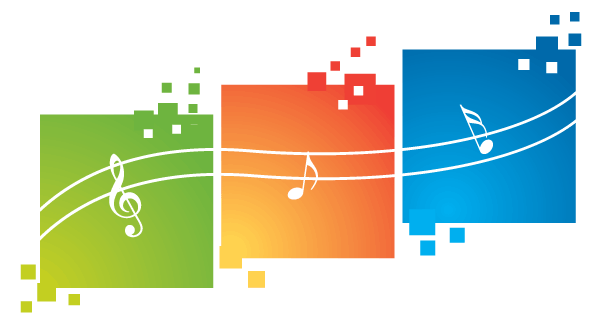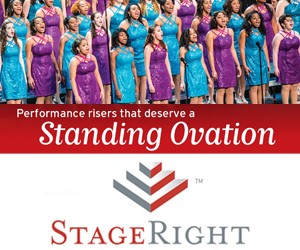
In other cases, the venue itself may not be acoustically adequate and part of the architecture creates unwanted sound or the sound system itself creates feedback. In all cases, unwanted sound is often annoying and distracting.
In the world of temporary staging, we are highly aware of the unwanted sound a staging platform can create, and we are continually trying to innovate solutions to unwanted sound when people walk on our staging products.
Because unwanted sound takes away from the performance on stage, venue experts focus a lot of attention on minimizing and eliminating it. When we build temporary stage extensions, seating risers or stage traps, we work very hard to not only produce platforms that match the permanent stage aesthetically, but also to blend in to the acoustics of the space as well.
The Need to Quantify Sound
We heard from several industry experts that various opinions existed about using honeycomb core lids, solid core lids, acoustical liners, and various carpeted surfaces in platforms to minimize sound, but the lack of data often made it difficult to recommend the right platform configuration for a particular theatre. And when a theatre consultant or venue manager asked us how various configurations performed acoustically, we responded with conjecture, rather than facts and data. So recently, we worked closely with the Acoustics Laboratory at the University of Hartford in Connecticut to help quantify the sound produced by various platform configurations. In other words, we wanted to bring data to a part of the staging industry that appeared to be lacking.
The Study
The acoustic experts at the University of Hartford were supplied 14 different platforms on which to conduct acoustical testing. The acoustic lab scientists utilized a tapping machine to simulate footfall noise on the platforms in a testing procedure commonly used to measure noise attenuation of flooring materials in multi-family housing (ISO 3741-Acoustics-Determination of Sound Power Levels of Noise Sources using Sound Pressure-Precision Methods for Reverberation Rooms). In essence, the tapping machine applies hammer-like pressure onto the various platform configurations while the sound produced is measured in a controlled acoustics lab.
After several tests, the tapping machine and sound room were considered stable and repeatable test methods for measuring the footfall sound on platforms. The sound produced by the tapping machine is measured in decibels (db’s) at a wide range of frequencies (Hz) for each platform. From there, we are able to compare the sound produced by multiple platform configurations.
The Results
In the end, we found that a solid core platform acoustically performs as well as a honeycomb platform; both platforms produced approximately 111 decibels of noise across all frequencies measured. The solid core platform is constructed with a 1″ Marine Tech plywood substrate (SC90 platform produced by Staging Concepts). The honeycomb platform is constructed with a laminated honeycomb core (produced by another industry manufacturer). Within the frequencies typically cited for footfall noise, each platform measured as follows (lower dB’s are quieter):
| Frequencies (Hz) | ||||
| 400 | 500 | 630 | 800 | |
| Solid Core Platform | 101 | 103 | 105 | 106 |
| Honeycomb Platform | 105 | 106 | 105 | 104 |
| *Measurement in dB’s | ||||
We also found that a solid core platform utilizing acoustical insulation significantly improves the acoustical performance of a platform. When we added acoustical lining to the underside of the platform, the sound measured across all frequencies is reduced by three decibels. Within the critical frequencies for footfall noise, platforms with and without acoustical insulations perform as follows:
| Frequencies (Hz) | ||||
| 400 | 500 | 630 | 800 | |
| Solid Core Platform (no insulation) |
101 | 103 | 105 | 106 |
| Solid Core Platform (WITH insulation) |
99 | 101 | 101 | 101 |
| *Measurement in dB’s | ||||
Finally, out of all platform configurations tested, a thickly carpeted surface utilizing a solid core and acoustical insulation reduces footfall noise the most. While not all venues want to have a carpeted platform, it is noteworthy to point out a solid core densely carpeted platform reduces the average sound over a solid core polyvinyl surface platform by 26 decibels.
Recommendations
In the end, if eliminating unwanted sound is important for your venue, we recommend using a densely carpeted solid core platform for your space. If you are unable to utilize carpet for your seating riser or stage extension, we recommend utilizing a solid core platform with acoustical insulation.
Eliminating unwanted noise will make the performance more enjoyable for your patrons and for the performers too. The staging platforms should feel and sound permanent as well as solid. We hope the data produced in this study helps consultants and venue managers make the best choices for their performing arts spaces. If you would like more information on the study conducted, please contact Staging Concepts at 1-800-337-2096 or at info@stagingconcepts.com.
Photography provided by Staging Concepts











